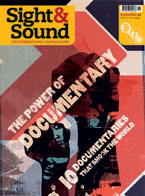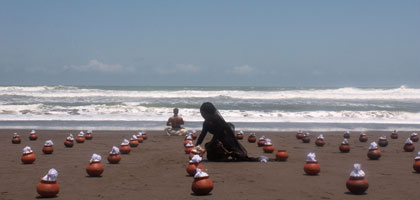
Opera Jawa
Indonesia/Austria/Netherlands/Sweden/UK 2006

Reviewed by Tony Rayns
Synopsis
Our synopses give away the plot in full, including surprise twists.
Umbul Makmur, a village in Java. The crops have failed and the local economy is in decline. The potter Setio and his wife, the former dancer Siti, are facing hard times; Setio takes his wares to a far-off market in the hope of finding better business. While he is away, the local butcher Ludiro (who has megalomaniac ambitions and has already bullied rival shops into closing) asks Siti to dance with him. Lonely and depressed - and pressured by her old gamelan teacher, who is indebted to Ludiro - Siti finally succumbs to Ludiro's advances.
Setio comes home and begins to doubt Siti's faithfulness. Village farmer Jecko is organising 'people power' resistance to Ludiro's exploitation of the impoverished masses. Ludiro tells his mother Sukesi about his passion for Siti, and she advises him to woo her with lavish gifts. Setio joins Jecko's resistance movement and tries to mould Siti into the image of her that he cherishes - but she resists, insisting that she is her own woman. An armed uprising against Ludiro begins. Ludiro longs to return to the womb, and Sukesi laments her fate as an earth mother. Many die. Setio kills Ludiro in battle, and then sorrowfully kills Siti, believing he has lost her. Setio is arrested. Sukesi leads village women in a requiem for the dead and pleads for love, which alone can free them from the will to power.
Review
Garin Nugroho's sensationally beautiful 'gamelan musical' is based on the single most famous episode from the Ramayana, the epic poem composed in Sanskrit, which is known throughout south-east Asia and revered as a quasi-religious text by Hindus. In the original, kings Rama (good) and Rahwana (evil) are rivals for the affection of Rama's queen Sinta. Rahwana abducts her; Rama rescues her and defeats Rahwana; Rama finally puts Sinta to the test of fire to prove her 'purity' - and kills her in the process. (These are the character names used in Java, where the story has been part of the shadowplay and dance-drama repertoires for centuries; the names differ slightly in other cultures.) Garin smartly re-reads the story as an attack on the will to power in matters political, economic and sexual, and even more smartly disguises the attack as a requiem for the victims of natural and man-made disasters, both of which Indonesia has seen to excess in recent years.
The film is much more than a modernist re-reading of the story. Commissioned to make it by Vienna's New Crowned Hope festival (curated by Peter Sellars, part of the city's Mozart Year), Garin has thought seriously about Javanese music for the first time since he made ...and the Moon Dances (Bulan Tertusuk Ilalang, 1995) and has worked with the musician Rahayu Supanggah to produce a film without precedent in east Asian cinema: fully sung to a phenomenal classical/pop score, with a parallel ancient/modern mix in the choreography, the language and the settings. The sets and props in fact deserve a chapter to themselves; created by Indonesia's leading installation artists, they include a butcher's slaughterhouse with carcasses hanging above blood-red candles in the shape of human heads, television sets carved from stone and wispy white muslin dummies hanging by the roadside to represent the dead. No film has looked or sounded like this before.
In Garin's version of the story, Rama and Sinta become the village potter Setio and his wife Siti, a former temple dancer. A prologue (sung by an enormously fat wayangstoryteller in the market) introduces them as avatars of their mythic forebears and suggests that their fate is preordained, though it also insists that 'truth' is a matter of opinion. There are circumstantial pressures on the couple, caused by the failing local economy and ecology, but the central problem is that Siti refuses her husband's attempts to mould her; the more she resists, the more paranoid and jealous he becomes. Garin 'rhymes' this man's attempted domination of a woman with the butcher Ludiro's attempts to take power by force, producing a textbook melding of the personal and the political. The ending is tragic: Siti dies at the hands of her husband not in a ritual demonstration of her 'purity' but in a straightforward murder. Setio kills her (in an orange silk 'vagina' installation on the beach) because he cannot bear the thought that she is not fully his.
This is not the first time that Garin has shown a woman to be stronger and more self-possessed than a man, but Opera Jawa is otherwise nothing like any of his other films, just as they were nothing like each other. A singular figure who kept Indonesian cinema going almost single-handed in its leanest decade, the 1990s, Garin is one of the few directors alive - Oshima Nagisa and Jang Sun-Woo would be other examples - who never repeats himself in style, tone or form. Here, by the very nature of the project, he's as much a ringmaster as a director, coordinating contributions from musicians, singers, dancers, designers and choreographers. But it would be laughable to suggest that the result is filmed theatre. Working with the Malaysian Chinese cinematographer Teoh Gay-Hian (previously best known for his work with Ho Yuhang: Min, 2003, and Rain Dogs, 2006), he has thought through an elaborate mise en scène of extended, mobile shots in which the realities of the locations and the artifice of the action and props are constantly in creative fission.
Inevitably, Opera Jawa will be dubbed 'exotic', in part because so few south-east Asian films are released here and in part because it's a gamelan 'opera'. But the film is in truth no less anchored in physical realities than Leaf on a Pillow (Daun di Atas Bantal, 1998), Garin's docudrama about delinquent street-kids in Yogyakarta. There are no special effects, and meaning is rooted in colour and texture as well as lyrics and actions. In a film full of arresting images, none is more striking than Setio's attempt to literally mould his wife, plastering her with clay and turning her on his potter's wheel.
Credits
- Directed by
- Garin Nugroho
- Produced by
- Garin Nugroho
- Screenplay
- Garin Nugroho
- Armantono
- 'This film is a version of The Abduction of Sinta'
- Director of Photography
- Teoh Gay Hian
- Editor
- Andhy Pulung
- Art Director
- Nanang Rakhmat H.
- Music
- Rahayu Supanggah
